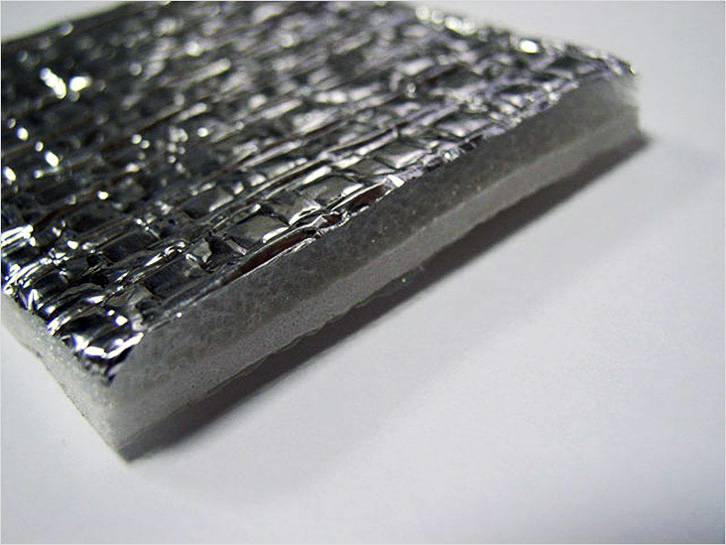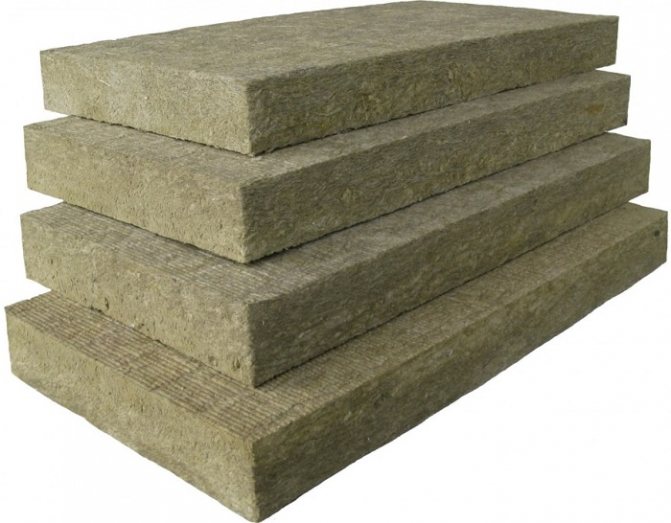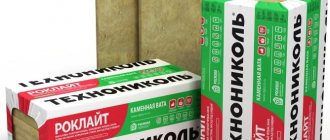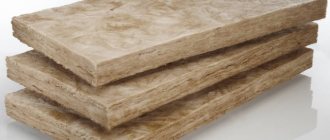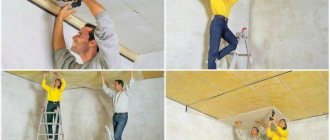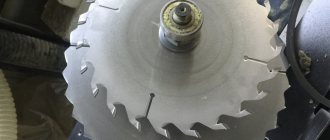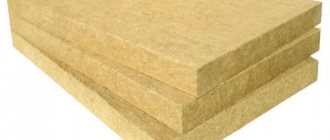Properties of mineral wool in slabs as insulation
The thickness of the insulation depends on the base
Mineral wool is a stone-based insulation that allows you to create thermal insulation for a building. Lava rocks for the manufacture of material are heated and melted. Binders are added to shape and tighten the fibers. The final product retains the properties of basalt:
- Thermal conductivity from 0.03 to 0.04 W / m - the ability of insulation to maintain temperature. With an indicator of a mineral material with a thickness of 10 cm, 25 cm of timber, 200 cm of sand-lime brick and 117 cm of ceramic are comparable.
- Density - the indicator ensures the use of plate isolate and on average equals 60-80 kg / m3. For arranging a pitched roof, you will need light slabs of 30-50 kg / m3, for a flat one - from 100 kg / m3. For industrial purposes, models from 160 kg / m3 are used that do not deform under the influence of an external load.
- Resistance to fire class NG. Basalt fibers are non-flammable, do not spread fire, and can heat up to +750 degrees. Non-flammable modifications are heated up to 1000 degrees for 2 hours.
- Moisture absorption. Min plates have an indicator of 1-2%, i.e. do not absorb condensation and precipitation.
The thermal conductivity index depends on the direction of the fibers. The best option is a chaotic location.
How the purpose of mineral wool affects its size
Insulation is necessary for any building in order to:
- reduce heat loss in winter;
- protect from overheating in summer;
- to preserve the elements of the supporting structure of the building from the effects of negative environmental factors;
- increase the service life of the structure.
These tasks are quite within the power of inorganic insulation. From a solid list of materials of this kind, mineral wool is in special demand. Mineral wool has long been successfully used in construction.
By giving preference to this type of insulation, the consumer receives the following advantages:
- thermal conductivity index 0.035 W / mk, one of the best;
- quality dielectric properties;
- high rates of vapor permeability;
- the best parameters of fire resistance;
- low hygroscopicity;
- high resistance to aggressive environments.
This material can be used for wall insulation, both inside and outside. It is used for roofs, attics and basements, and interior partitions. Its dimensions are of the same standards as the distance between the guides where the mineral wool is laid. If there are violations of standards in construction, it becomes necessary to adjust the size of the insulation.
Please note: manufacturers of mineral wool produce their products in sizes that are maximally adapted to the standards of modern construction.
Advantages and disadvantages
Benefits of basalt wool
Products are delivered rolled up and then cut out. Mineral wool is suitable for all types of insulation work due to the advantages:
- sound insulation - can be installed in houses next to the roadway and production halls;
- lack of cold bridges - sheets do not shrink at joints;
- special structure - the fibers are located in a chaotic direction or intertwined, which prevents the removal of warm air from the room;
- ease of installation - slabs can be easily cut with a knife or hacksaw in place;
- durability - the insulation retains its properties for 20-70 years;
- environmental friendliness - made on the basis of natural basalt rocks.
The disadvantages of miniplates include the complexity of installation due to high vapor permeability.
How should mineral wool be applied?
When using mineral wool as a heater, one should strive to choose the optimal density of the slabs, based on the object of insulation, as well as the information on the compaction coefficient provided by the manufacturer. When preparing a professional project for insulation, complex calculations are used, but in practice, when insulating their houses, their owners act more on a whim.
Mineral wool is available in the form of mineral mats, mineral felt, semi-rigid and rigid slabs.
Characteristics of mineral wool insulation.
Mineral mats are a piece of mineral wool carpet, which is enclosed in bituminized paper, fiberglass or a special metal mesh on both sides, and stitched with a strong thread for better fixation. Mineral mats have standard dimensions 50x150 cm, their thickness can vary from 2 to 10 cm, and density from 100 to 200 m³
Such mats are used mainly in industry, for thermal insulation of equipment and pipes, since their dimensions allow to insulate pipes of various diameters. Such mats can withstand temperatures of 400 ° C, and on the basis of a metal mesh and up to 600 ° C without any damage to their thermal insulation properties. Due to their large size, mats are rarely used for insulating private houses.
Mineral felt is produced both in sheet and in roll form. The cotton wool in the felt is impregnated with synthetic resins, which significantly improves its thermal insulation properties. Its density becomes 75-150 kg / m³, and its thermal conductivity is 0.046-0.052 W / (m-K).
To make semi-rigid boards, synthetic resins or bitumen are sprayed onto the mineral fiber, and then pressed and dried. The density of such slabs depends on the compaction force and ranges from 75 to 300 kg / m³. The dimensions of the slabs are 60x100 cm, the thickness can be up to 20 cm. Plates with synthetic fillers can be used to insulate structures with temperatures up to 300 ° C, and with a bitumen binder, no higher than 60 ° C.
Mineral wool production scheme.
Rigid mineral wool boards are obtained by mixing mineral wool with synthetic resins and then polymerizing and pressing it. The density of such slabs ranges from 100 to 400 kg / m³, the dimensions are the same as those of semi-rigid ones, 60x100 cm (thickness from 4 to 10 cm).
Each of these types has its own purpose. Mineral felt and mineral mats are mainly used for insulating engineering communications (pipes) of various diameters, as well as horizontal planes (floor, ceiling).
Semi-rigid and rigid slabs are used to insulate both horizontal and inclined planes (slopes and decorative elements), and rigid slabs, due to their rigidity, are used to insulate the vertical planes of the walls.
Back to the table of contents
general information
Mineral wool is produced according to the technology that has already become a classic. This is the use of raw materials from rocks such as basalt, which are processed under high temperature.
After remelting, the result is combined with special chemicals and stone wool fibers are obtained. Cotton wool is already created from the fibers themselves, as a full-fledged building material.
As you can imagine, this initial structure affects the properties of mineral wool. So, its thickness should be quite impressive so that the fibers can stick to each other. Also, cotton wool has a high density, does not react to many external influences, etc.
Moreover, the density of mineral wool is really high. Especially if plate heaters are taken into account. Here the density of the board can be equal to the density of the foam. And at the same time, the thickness of the material will have little effect on its density, as well as the size. But this factor still needs to be taken into account.
This insulation is almost ideal for decorating walls and insulating walls of an apartment from the inside, since its installation is carried out using the simplest technology. If desired, it can be combined with other materials. For example, lay drywall, siding, etc. over mineral wool.
Dimensions and shape of mineral wool
Mineral wool insulation is produced in two main types or forms. Vata is found in:
- Rolls;
- Plates.
Cotton wool in rolls are long strips of mineral insulation that are rolled into a small roll. Its length in unfolded form can reach 7-10 meters, but its width rarely exceeds 1.2 m.
Mineral wool slabs
The roll thickness is 50 millimeters maximum. This size of the workpiece allows you to safely transport rolls of insulation, without spending too much space on its placement.
Cotton wool in rolls is most often used cheaper. It absorbs moisture faster, it can settle over time, and its installation on the walls is not carried out using the easiest technology. The density of the cotton wool in rolls is also, as a rule, lower than the density of the insulation in the slabs.
To fix the roll and insulation to protect the walls of the house with high quality, you will have to tinker seriously. After all, first it must be spread (and it is not so easy to do this on a vertical wall), and then also fixed. It is not possible to cope with such work alone.
And the size of the roll, or rather its length, must also be taken into account. If it has a length of more than 6 meters, then using material in this form for wall decoration will be simply unproductive (it will have to be cut additionally).
But the mineral wool in the slabs was specially created for wall decoration and other vertical structures.
The slab size is on average 1000 × 1200 mm. Its width can vary, but a length of 1200 mm is considered almost the standard.
The thickness of the slab can vary depending on its purpose. So, the thickness of the slab for floor insulation can be only 30-40 mm. But the thickness of the facade slab or insulation for thermal insulation of a flat roof can be up to 80-100 mm or even higher.
The size of the slabs of liquid thermal insulation allows them to be conveniently laid anywhere. Their installation is carried out even independently, and from the available tools you will need only a few tools.
The density of the insulation in the slabs also changes significantly. Heaters for roof slopes have an extremely low density. For this type of slab, such a parameter is a real necessity.
Slabs for walls or flat roofs, on the contrary, have an increased density. It is already possible to walk on them with the load, without fear that the mineral wool will bend or deform.
Mineral wool properties
Let's turn directly to the properties of mineral wool, for which it is so appreciated in the construction industry. And by the way, she has just a huge amount of positive properties.
Features of mineral wool for insulation
Modern construction cannot be imagined without the use of mineral wool as an insulating material. It has a wide range of uses, which makes it particularly popular with builders. The most common use of mineral wool is to insulate building structures.

Manufacturers produce products of different types and purposes: plates, mats, rolls, cylinders
Usually, roofs, floors, walls and ceilings are insulated with mineral wool: the size of the materials depends on the area of the room and the type of insulation.
Mineral wool is often used to lay the middle layer. At the same time, loads on the insulation of various types of surfaces in any buildings, houses and structures are avoided. Vertical laying of mineral wool is used to insulate facades and walls.The inclined and horizontal laying method is chosen for insulation of the ceiling, roof and roof.
What is mineral wool used for:
- For equipping ventilated façade systems and for installation in curtain walls.
- Mineral wool is used to insulate building sandwiches of panels and blocks, which are used to build multi-layer walls with different types of cladding. They can be metal, concrete, particle board, fiberboard and OSB.
- To insulate various industrial structures, equipment and pipelines.
Related article: What putty to choose for the walls under the wallpaper
Modern manufacturers offer consumers different types of general construction insulation. Cotton wool can be presented as a lightweight heat and sound insulating material that does not have a coating. Another option is cotton wool with one-way caching using aluminum foil. Cotton wool can be equipped with special sound-absorbing material.
Why are mineral wool sizes needed?
Mineral insulation has a lot of advantages, which makes it possible to choose it as the main material for the installation of a heat-insulating system. To accurately calculate the required amount of material, you should know the dimensions of the mineral wool slabs that you decided to use in your work. If, when buying heat-insulating material, it is necessary to take into account the cubic capacity, then in a number of works it is necessary to take into account the dimensions of the mineral wool.
In what cases are the dimensions of mineral wool taken into account?
When installing a heat-insulating system with the creation of a frame, pre-specified dimensions of mineral wool slabs, which are optimal for thermal protection in a given region, allow preparatory work to be carried out in advance, which makes it possible to reduce the time for creating thermal protection. These can be works:
- for floor insulation, since the insulation plates should be tightly laid between the logs;
- when insulating the attic, since the size of the mineral wool affects the size of the cells or the step of the lags, between which the insulation is tightly packed.
For outdoor work, a frame can also be pre-created, into which plates of heat-insulating material are then carefully inserted between the profiles or wooden slats.
Needless to say, the high performance characteristics of mineral slabs, their elasticity and appropriate density, allow, if necessary, to cut off a piece in order to neatly put it in the right place. But do not do this during the entire installation process. Yes, and unnecessary joints - no one needs.
What sizes are mineral wool slabs?
It is generally accepted that the standard sizes of mineral wool, which are the most popular with buyers, are 1000 mm x 500 mm. Since the choice of the thickness of the insulation depends on the insulated structural element and the region of residence - it is determined in each specific case. The thickness of the insulating material can, however, affect its dimensions, since plates with a thickness of 150-200 mm are also available in larger widths - up to 600 mm.
In principle, each manufacturer produces its own products, the sizes of which may differ from the usual ones. For example, Isover suggests:
- the size of the min-plate Isover frame P-32 is 1170 by 610 mm (the thickness varies from 40 to 150 mm);
- Isover frame P-34, the thickness of which varies from 40 to 200 mm, has dimensions of 1170 by 610 or 565 mm;
- the slab used for the "floating floor" system, with a thorn-groove edge, with a thickness of 20 to 50 mm, has already other dimensions - 1380 by 1190 mm;
- Isover rigid slab for a flat roof, 30 mm thick, has dimensions of 1550 by 1180 mm.
Advantages and disadvantages
Now we can create a complete list of pros and cons to structure the knowledge presented.
Exterior decoration of the facade of the house with mineral wool slabs
Main advantages:
- High density;
- The ability to mount in a short time;
- Non-flammability;
- Hydrophobicity;
- Environmental friendliness as when insulating a hangar using polyurethane foam;
- It is not gnawed by rodents, insects, etc .;
- Water vapor permeability.
We have already noted the main disadvantages - this is a high price. You will also have to pay more for the installation of mineral wool. The installation process, although simple, is quite laborious in terms of mechanical work.
Brief description of the material
Cotton wool for wall insulation is the best price-quality ratio while creating a comfortable living environment. It consists of a large number of fibers that are obtained by a specific processing method. They can be made of glass, slag, stone. The density of any mineral wool, measured in kg per m3, also depends on the material of manufacture. The insulation has a number of advantages, among them:
- Ease of installation. Mineral wool can be presented in the form of a roll or plates that hold their shape.
- Light weight of the material, which allows it to be used for floors, without weighing them down.
- Convenience of subsequent finishing. This indicator depends, among other things, on the density of the insulation.
- Environmental friendliness - mineral wool is created from natural materials, which allows it to be completely safe.
- The material is a good sound insulator.
- Non-flammability - it melts, but does not burn.
There are also disadvantages and they should be taken into account when insulating with mineral wool:
- Glass and slag wool are very prickly, this must be taken into account during the installation process. Stone wool is practically free from this disadvantage.
- The material, together with air, allows moisture to pass through, which leads to the loss of its technical characteristics. To avoid this, it is necessary to isolate the insulation from moisture.
- To buy high-density mineral wool, you will have to spend a lot of money, but the result will exceed expectations.
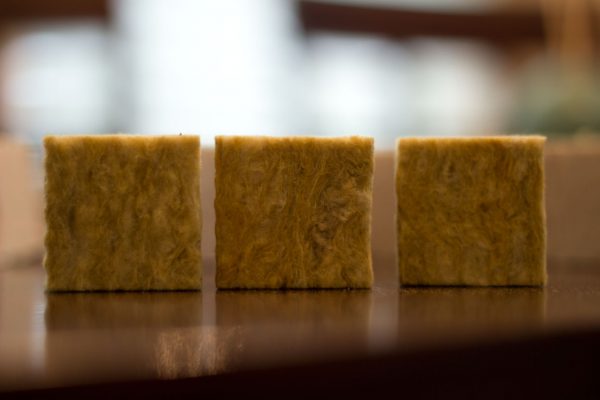

Insulation structure with different density indicators
Types depending on the material of manufacture
The 3 options for thermal insulation plates made of mineral wool are related to - glass wool, stone and slag wool.


These varieties have a specific width of mineral wool, fiber length and technological parameters that establish their popularity for use in a particular area.
Slag
Slag wool is produced from electrode blast furnace slag, has a fiber size from 4 to 12 microns and a length of 16 mm. Thermal conductivity is 0.48 W / mK with increased hygroscopicity. Mineral wool dimensions - 500 × 1000X50 mm. This modification is hydrophobic and more than others has a predisposition to moisture, which does not make it possible to use it on external roofing insulation, and its low level of fire safety excludes its use in attic rooms.
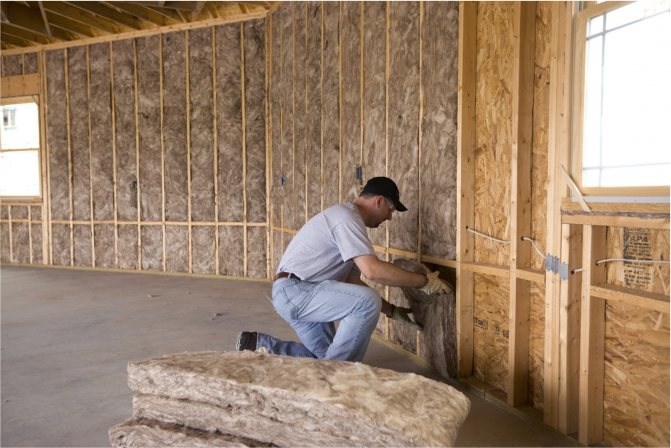

Another disadvantage is that the fibers are rather brittle, and it is possible to work with such material only with gloves. Despite all this, given the good flexibility and uniform thickness, it is quite convenient to work with such a material. In addition, the slag is not heavy, even a decent amount of mats does not form a load on the roofing system. It has a very light structural structure, thermal conductivity 0.048 W / mK.


Due to its own texture, it has a high vapor permeability and hygroscopicity, and therefore, with this type, it is necessary to use waterproofing.
Glass wool
Glass wool - refers to budget building materials for thermal insulation. At the same time, it has a very good density and elasticity, with a thermal conductivity coefficient of 0.050 W / mK. It is made from the same consumable material as ordinary glass - sand, soda, dolomite and limestone. Fiber size up to 15 microns. The dimensions of the mineral wool insulation in the slabs are 1250X600X50 mm.


The admissible temperature regime is + 450C. The main advantage is the relatively low price.The disadvantages are low performance and a high risk for the respiratory organs of humans and the skin, which makes it necessary to quickly perform insulation work, with dense protection of the laid layer with surface material, while the employee must use special clothing, respirators and goggles when working.
Dimensions of mineral wool form of release and dimensions
The volume of production of the Russian mineral wool market is steadily increasing. The highest figures for 2013 are admirable, with a 52.5% increase over 2009.
The share of use of mineral wool in construction has increased from 46% in 2010 to 60% by now. Starting from mid-2017 and in subsequent years, growth in the production of mineral wool products is forecasted.
This success is attributed to many factors. This is an increase in apartment building, and the growing popularity of suburban housing, and an increase in industry in general. However, an important factor is a thoughtful study of the needs of the construction market by product manufacturers.
Knowledge of the required technical and operational characteristics, dimensions and dimensions of mineral wool, understanding what a builder needs to build quality housing, allows the manufacturer to produce the products that will be in demand.
Main categories
Insulation for walls is divided into 2 groups:
- For internal insulation.
- For external insulation.
These categories differ from each other only in the ability to pass steam or retain it. Mineral wool, packaged in slabs, mats, rolls, is easy to use, easy to cut and fills in the most inaccessible corners, leaving virtually no waste after cutting.
TechnoNIKOL
- Technofas. It is produced in the form of a 600 * 1200 * 50/100 slab with a density of 145 kg per 1 m3.
- Technoven Standard. Plate. Dimensions 600 * 1200 * 50/100, density 80.
Knauf
- Insulation FKD. Slab (600 * 1200 * 20-160, density 140-150.
- Insulation FKL, plate. 200 * 1000 * 20-200, density 85.
- Insulation FKD-S, slab 600 * 1200 * 60-180, density 140-160.
- Insulation HTB, plate 1000 * 500 * 20-180, density 35-150.
Rockwool
- Fasrock, roll 1000 * 600 * 100, density 135.
- Wentirock max, roll 1000 * 600 * 50, density 50-90.
- Panelrock, plate 1000 * 600 * 50-100, density 65.
ATTENTION! The fine-fiber structure of mineral wool contains formaldehyde, therefore it belongs to carcinogenic building materials. For safe installation, it is necessary to have special protection for the worker performing the insulation or insulation. To prevent scattering of fibers throughout the room, the pressed plates should be protected with membranes. And only after that start finishing work.
The choice of insulation density
Before deciding which insulation density to choose, it is necessary to determine where it will be installed. If wall insulation is planned, the type of cladding plays an important role. It determines the type and density of the heat insulator. So, for a residential building, it is recommended to use basalt wool, which has low thermal conductivity, high fire resistance and environmental friendliness.
For cladding with siding, a basalt heat insulator with indicators of 40-90 kg / m³ is suitable. The higher the thermal insulation is, the higher the indicator should be. If the surface will be plastered, then you need to choose a special thermal insulation for facade work. The density should be 140-160 kg / m³. In these works, special elements are used that have high vapor permeability and peel strength. For interior work, a low-density heat-insulating material is used.
For roofing work, the choice of insulation depends on the type of roof. If the roof is pitched, choose a heater with indicators of 30-45 kg / m³. For insulation of the attic, the indicator should be at least 35-40 kg / m³. A flat roof must withstand heavy loads from snow, wind and other atmospheric phenomena. Therefore, in this case, thermal insulation with a density of 150 kg / m³ should be used if mineral wool is used. For expanded polystyrene, this figure should be no more than 40 kg / m³.
To insulate the floor from the cold, you should choose a material for which the mass pressure per unit volume is sufficiently high. However, if you plan to lay the material between the logs, you can use loose insulation.The logs take on the entire load, and the thermal insulation is not tasked with withstanding the pressure exerted.
Recommendations for the thickness and density of mineral wool
Taking into account the climatic characteristics of the region is of decisive importance when choosing the size of the insulation. For the outer walls of houses located in areas of a temperate continental climate (Moscow, Leningrad, Volgograd and other regions), it is recommended to choose slabs with a thickness of 80-100 mm. With the remoteness of the region from this area (continental, sharply continental, monsoon, maritime climate; subarctic, arctic belts), the thickness increases by about 10%. For example, for the Murmansk region, it is advisable to take a mineral wool 150 mm thick on the outer walls, and for Tobolsk the correct range will be from 90 to 110 mm.
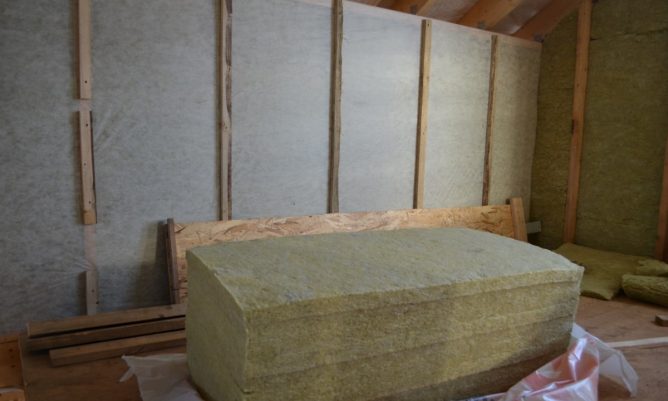

Insulation with a density of up to 40 kg / cu. m is used only in unloaded horizontal surfaces, so it is better to ignore them. Such cotton wool is produced in rolls, rolled out on sheathed interfloor partitions, floors, etc. For insulation of external walls of non-residential or industrial premises, the indicator varies from 50 to 75 kg / cu. m. If the user makes a ventilated facade, the slabs should be even denser - up to 110 kg / cu. m. Otherwise, the indicator can reach 130-140 kg / cu. m, but on condition that later the walls will be plastered. The first option implies the subsequent finishing with siding or a similar method of finishing work in order to extend the service life.
Structures insulated with basalt slabs
The use of basalt wool is quite wide. Manufacturers produce basalt wool for insulating various surfaces. Consider the brands, sizes and density of basalt wool from leading manufacturers for insulating facades, walls, partitions, floors and roofs.
Thermal insulation of facades with basalt wool
Stone mineral wool is used to insulate facades. This can be a layer of thermal insulation for "wet" and ventilated facades. Thermal insulation of facades with cotton wool is the most popular among the options for insulating modern buildings for any purpose. This option of thermal insulation serves for a very long time - more than 40 years.
Manufacturer Brand Type Dimensions, mm Density, kg / m3
| TechnoNicol | TECHNOFAS | plate | 600×1200, 50 (100) | 145 |
| TECHNOVENT STANDARD | 600×1200, 50 (100) | 80 | ||
| Knauf | Insulation FKD | plate | 600×1200, 20-160 | 140-150 |
| Insulation FKD-S | plate | 600×1200, 60-180 | 140-160 | |
| Insulation FKL | plate | 200×1000, 20-200 | 85 | |
| Insulation HTB | plate | 1000×500, 20-180 | 35-150 | |
| Rockwool | Fasrock | roll | 1000 × 600X100 | 135 |
| Panelrock | plate | 1000x600x50-100 | 65 | |
| Wentirock max | roll | 1000x600x50 | 50-90 |
Popular materials of the TechnoNikol company: TECHNOFAS and TECHNOVENT STANDARD; Rockwool companies: Fasrock, Wentirock max and Panelrock; and Knauf companies: Insulation FKD, Insulation HTB and others.
Basalt wool for insulating partitions and walls
Manufacturer Brand Type Dimensions, mm Density, kg / m3
| TechnoNicol | Mat TechnoNICOL ordinary | roll | 1000x4000, 50 (100) | up to 30 |
| ROCKLIGHT | plate | 600×1200, 50 (100) | 30 | |
| TECHNOLIGHT EXTRA | plate | 600×1200, 50 (100) | 30 | |
| TECHNOLIGHT OPTIMA | plate | 600×1200, 50 (100) | 35 | |
| TECHNOBLOCK STANDARD | plate | 600×1200, 50 (100) | 45 | |
| Knauf | Insulation LMF Alur | roll | 1000×2500, 20-100 | 35-90 |
| Rockwool | Domrock | roll | 4750×1000, 200 | 20 |
| Superrock | roll | 1000x600x50 | 35 |
Basalt wool slabs are used for internal and external wall insulation. The material provides good thermal protection of the room from the inside, in addition, it provides excellent sound insulation. Mineral wool slabs are suitable for noise insulation of interior partitions in offices and living quarters. But given the fact that low density basalt wool is used for these purposes, it is more rational to use the material in rolls. This simplifies installation work. For example, the manufacturer Knauf produces Insulation LMF Alur mats for insulating partitions, while Rockwool produces Domrock and Superrock rolls.
Thermal insulation of floors with basalt wool
Manufacturer Brand Type Dimensions, mm Density, kg / m3
| TechnoNicol | ROCKLIGHT | plate | 600×1200, 50 (100) | 30 |
| Teploroll | roll | 4000Х1000, 50 (100) | 30 | |
| Knauf | Insulation LMF Alur | roll | 1000×2500, 20-100 | 35-90 |
| Insulation PVT | plate | 600×1000, 20-120 | 175 | |
| Rockwool | Rockmin plus | plate | 1000x600x50 | 31 |
| Rockton | plate | 1000x600x50-120 | 50 | |
| Superrock | roll | 1000x600x50 | 35 |
Basalt wool is an irreplaceable material for thermal insulation of floors. Basalt insulation slabs are used for flooring. They are distinguished by high rigidity, perform the functions of sound and heat insulation. The material is placed under slabs, joists and under the screed. In addition, basalt wool slabs are used in such a popular system as "floating floor".
Thermal insulation of flat and pitched roofs with basalt wool
Stone wool in the form of slabs is widely used for roof insulation. On the modern construction market there are special boards used exclusively for thermal insulation of roofs.
Manufacturer Brand Type Dimensions, mm Density, kg / m3
| TechnoNicol | ROCKLIGHT | plate | 600×1200, 50 (100) | 30 |
| TECHNOLIGHT EXTRA | plate | 600×1200, 50 (100) | 30 | |
| TECHNOLIGHT OPTIMA | plate | 600×1200, 50 (100) | 35 | |
| TECHNOBLOCK STANDARD | plate | 600×1200, 50 (100) | 45 | |
| Knauf | Insulation DDP | plate | 600×1200, 20-180 | 150-200 |
| Insulation DDP-K | plate | 600×1200, 40-160 | 105-110 | |
| Rockwool | Dachrock max | plate | 2000×1200, 40-200 | 130-210 |
| Domrock | roll | 4750×1000, 200 | 20 | |
| Megarock | roll | 3000 (6000) x1000x200 (100) | 28 | |
| Monrock | plate | 2000x1200x50-200 | 115-200 | |
| Rockmin plus | plate | 1000x600x50 | 31 | |
| Rockton | plate | 1000x600x50-120 | 50 | |
| Superrock | roll | 1000x600x50 | 35 |
Basalt insulation for the facade in Sevastopol
The facade of a house, building and structure is one of the most important elements of the exterior. At the same time, the original decorative finishes of the facade can be supplemented with no less important arrangement, a modern insulation system that allows you to reliably keep the warmth and comfort of the living space. Basalt wool for facades of various types and methods of arrangement is in special demand in the modern market. The impeccable thermal insulation qualities of basalt rock wool make it possible to equip a comfortable warm home.
Stone wool is an environmentally friendly natural insulation that has proven itself in the modern construction market as a versatile, durable, reliable type of thermal insulation for the facade. At the same time, the material practically does not change its qualities over the long years of operation of the building. The hydrophobic properties of the material are of great importance, stone wool for the facade has a bactericidal and fungicidal effect due to the special qualities of basalt.
You can choose a natural, environmentally friendly material for insulation from different manufacturers; you can buy mineral wool for the facade in the most optimal price segment for a wide consumer audience. A wide range of materials for thermal insulation is offered by our online store of building materials, including basalt wool from the world's leading manufacturers.
Pay attention to the following products: Rocklight insulation, Technovent standard, Isovent, LIGHT BATTS.
At prices, basalt wool for the facade compares favorably with other materials for thermal insulation. Therefore, when choosing the ratio of the quality of mineral wool for the facade, basalt wool has an advantage.
What technologies can be used for thermal insulation of facades?
Modern technologies of thermal insulation using mineral wool for the facade can include insulation:
- brick facade, with a well or Bavarian masonry, three-layer brick masonry,
- block walls,
- ventilated facades,
- wet facades with light plastering,
- other types of facades.
Thermal insulation of facades can be carried out in accordance with the climatic zone in which the dwelling is located. No less important criteria for calculating the thickness of thermal insulation for a facade can be the thickness of walls, enclosing structures, decorative finishes and elements. The choice of the optimal thickness of the insulation and the required type of building mixture allows you to ensure the appropriate quality of the future thermal insulation of the facade.
The technology of arranging thermal insulation with light plaster can provide for the sequential performance of construction work:
- for high-quality wall cleaning and priming,
- applying an adhesive mixture under the insulation,
- installation of thermal insulation boards from a renowned manufacturer,
- fixing dowels, which are selected in accordance with the thickness of the mineral wool slabs,
- arrangement of waterproofing composition,
- installation of facade reinforced fiberglass mesh,
- decorative or mosaic wall plastering, paint application from world famous brands.
The simplest technology is the arrangement of thermal insulation of a facade with a brick cladding. In this case, the insulation is laid between the load-bearing wall and the cladding made of a well or Bavarian masonry. But in any case, basalt wool allows you to reliably insulate a house and equip a comfortable home according to European standards.
Basalt insulation for the facade in Sevastopol
Basalt insulation for the facade in Sevastopol The facade of a house, building and structure is one of the most important elements of the exterior. At the same time, the original decorative finishes of the facade
Other important markings
In order to understand in what form the insulation will be presented, you should consider additional markings on the packaging. Namely:
- P-75. The number means density, the less dense the mineral wool, the more convenient it is to roll it up. This is exactly the case. Such types are used for walls that will not take on the bearing load.
- P-125. These are already slabs, they are used for the ceiling, floor. She has increased sound insulation properties.
- PPZh-175. In addition to the fact that the density of this stone wool is 175 kg / m³, it also has increased rigidity, as evidenced by the marking "Zh".
- PPZh-200. The densest mineral wool, which is also fire resistant.
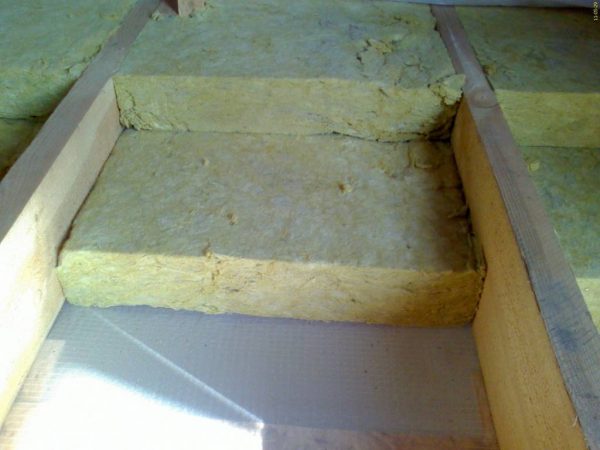

Mats are comfortable to use on the floor
Tips from experts
Finding out the dimensions of stone wool is often necessary in order to calculate how much material is required for insulation. Do not think that it is too easy, often buy too much or, worse, too little material. In order not to make mistakes in calculating the amount, you need to take into account the following points:
- Almost every package indicates how much area one "portion" of mineral wool can cover. It is this information that will help determine how many packages are needed.
- Do not forget that stone and any other mineral wool has such properties as shrinkage - it is better to buy it with surplus. Therefore, about 15% should be added to the results obtained. This will help prevent gaps from forming.
- In order for the consumption of insulation and waste from it to be minimal, it is necessary to calculate the optimal distance at the stage of construction or installation of the lathing, often it is 50-60 cm.
- It is imperative to double-check the size of the roll or sheet of insulation, since they may differ even from one manufacturer. As well as the area of the roll.
In general, to calculate the required amount of stone wool you need:
- Determine the area to be insulated. To do this, multiply the length by the width. If the area is not of a standard shape, then it must be divided into component parts.
- Determination of the perimeter of the house if everything is insulated - walls, ceilings, floors. Multiply the perimeter by the height and by the number of floors, if there are several.
- If you also need to insulate the roof, then calculate its area.
- It remains to add up the dimensions obtained and do not forget to add about 15% to trim the seal.
Important! Manufacturers do not take the dimensions of rolls and mats from the ceiling, they are due to building codes that help standardize the process of building insulation of houses.


Mineral wool can be of different thickness from the same manufacturer
Let's calculate the required amount of insulation
It is useful to consult with a professional on any questions. For example, which wool is better for a particular object - stone wool, the one in which basalt rocks are used, the so-called basalt wool, or another.
Will you need foil wool, what mineral wool materials will be needed in general, and is it possible to optimize costs.
For example, let's calculate the required amount of insulation for the roof.
Stage one:
- we calculate the roof area;
- add the area of attic walls and partitions;
- add 3% to the total.
Stage two. We choose the insulation, the roll area of which most closely matches the area of the insulation.We consider the material and sheet, and in rolls, and in mats.
Stage three. We divide the roof area by the area of the insulation squares and multiply the unplanned number of layers. The amount received will determine how many sheets, rolls to buy, how much panel material will be required in pieces.
Masters advise: be sure to add 10-15% to the result obtained. There is always a lack of material.
In order not to waste money on the insulation bleed, carefully calculate the size of the room, carefully analyze everything that is written on the packaging of this or that insulation. However, even if the minelite or roll tape was cut, there is nothing wrong. Waste will come in handy for insulating house buildings.
Mineral wool is considered almost the best insulation in the country's construction market. The sizes of different brands of these products are almost the same.
The dimensions are dictated by building codes, this standard approach optimizes the construction process in many ways.
When choosing a heater, it is important to take into account technical characteristics, professional advice on the purpose of a particular material, length, width, thickness and other important indicators. A significant characteristic is the density
Usually it is 11-350 kg / m2 kW. The highest density cotton wool is used for internal partitions, has dimensions similar to other types of insulation
Density is a significant characteristic. Usually it is 11-350 kg / m2 kW. The highest density cotton wool is used for internal partitions and has dimensions similar to other types of insulation.
Watch the video, which explains the nuances of counting and laying insulation:
What kind of wool is better to choose for thermal insulation of the roof, floor and walls
The most important thing in the selection of building materials is the thickness of the slabs. It depends on the following conditions:
- Dew point position;
- atmospheric climatic region of the location;
- roofing system design;
- the ability to withstand the load;
- thermal conductivity of a variety of insulating material;
- the form in which it is manufactured.
Additional Information! The width of the roofing slabs is available in a variety of modifications. In order to get away from difficult types of calculations, it is better to choose the insulation parameters that are recommended for different climatic regions. So, for example, in the southern regions, mineral wool sizes vary in the range from 120 to 180 mm, then in the central regions - 180-240 mm, and in the northern regions up to 360 mm with an average heat resistance of a heat insulator - 0.04 W / mK.
Mounting errors of mineral wool boards
- Lack of surface preparation. It should be flat, clean and treated with an antiseptic (if it is a tree).
- Carrying out work during precipitation or leaving finished work without rain protection.
- Insufficient adhesive application. Correct when it is distributed over the entire surface, including the perimeter. The most suitable adhesive is polyurethane foam or dry mix. The first products are easier and faster to work with, but slightly more expensive. Both products are resistant to external influences and guarantee good adhesion.
- Unfilled seams between insulation parts. They can only be closed with inserts of the same material. The maximum clearance is 2 mm.
- Intersection of slabs in window and door corners. There should be no joint in these places.
- Lack of mechanical fasteners. Anchors and dowels are used as additional connections for heavy sheets. The optimal amount is 3-4 pieces per piece (two at the corners, 1 or 2 in the center).
- Smooth mounting, joint to joint. Masters advise to install the elements in a checkerboard pattern - this way it is easier to avoid cracks in the structure.
These are the main mistakes people make when doing thermal insulation at home on their own.
Varieties of mineral wool and their distinctive characteristics
Mineral wool is a fibrous material produced in the form of mats or rolls and obtained from melts:
- glass (glass);
- blast-furnace slag of metals (slag);
- eruptions of rocks (stone or basalt wool).
Each of the options has different thermal conductivity and operating temperature limits. Plus, many manufacturers add their own components to the composition to achieve the unique characteristics of the produced insulation.
Glass wool is the most widespread and well known for a long time. It retains its characteristics at temperatures ranging from -60 C to +450 C and has good thermal conductivity of 0.38-0.45 W / m * K.
Slag in terms of thermal conductivity is somewhat worse, but only by 5-10%. But at temperatures above 300 C, it begins to sinter and lose its insulating properties. It also has the worst hygroscopic properties among analogs, it absorbs moisture with ease. And for all mineral wool, water is the main enemy. After absorbing moisture, their thermal insulation characteristics are sharply reduced.
Basalt wool is capable of properly performing its functions at temperatures up to +600 C, and some options up to +1000 C. Its thermal conductivity from various manufacturers fluctuates around 0.035-0.05 W / m * K. Plus, it has better vapor permeability, the walls will be more "breathable"
All mineral wool is non-flammable.
All of them are afraid of moisture and during installation it is imperative to install a high-quality vapor barrier. Otherwise, they will absorb moisture, which, when the air temperature drops, can simply turn into ice and destroy the material.
And everyone has a common drawback - the fragility of the fibers during installation and, as a result, many small pieces that penetrate everywhere and cause severe itching. Which can cause serious breathing problems. Therefore, when working with all mineral wool, gloves and a respirator with goggles must be worn.

